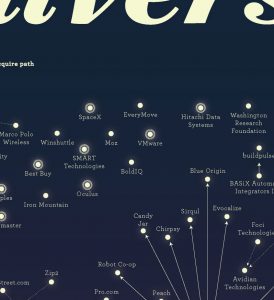Information Age publishes BoldIQ Opinion on Driverless Cars

A new age of mobility is upon us – and I am not talking about phones. With companies like GM and Lyft joining forces, it is a race to see which conglomerate will launch a network of autonomous vehicles first. As we begin seeing fleets of driverless vehicles hit the street, what will this future look like and what steps will the industry need to take to make this a reality?
The current focus on the driverless car itself is great and warranted. Will the car be safe, how will it deal with extreme driving cases, changing weather, accident prevention. However, as we work toward resolving these questions, we should not forget another overarching question: what will our world look like with all these driverless cars. Will they simply replace our current standard cars? Should we expect more congestion?
In the future, maybe 50 years from now, we will probably see an overarching infrastructure managing transportation resources from publicly scheduled transport to private on-demand transport. While this kind of single network layer – operating from above to connect vehicles and create the ultimate efficiency model – might be a utopian dream (at least for now), we can expect to see companies like Google, Lyft, Uber, GM and others begin to implement their own network layers to at least optimize their own fleets and reduce the required resources to meet demand. If they don’t, all we will see is more cars on the roads, more congested traffic, more waste, and on average, financial losses for the operators. This is exactly what happened with airlines after deregulation. Everyone wanted to be the ‘winner’, there were too many planes, huge waste and inefficiencies, and on average everyone lost money. In order to prevent these negative outcomes, we can expect companies eager to get their driverless cars on the road to implement some sort of overarching technology that will allow them to optimize their fleets of vehicles.
This would include a way for fleets to anticipate and respond to demand and challenging disruptions like traffic, accidents and weather. If companies start to implement this layer, it will enable a better use of resources and fewer cars on the road. Not only will this eliminate a future packed to the brim with autonomous vehicles around every corner, but energy waste and the need for expanded infrastructure like parking lots will be minimized as well.
Think about how many people are driving from similar locations to the same destination commuting to work every day? Or attending a ball game? How many of those cars sit in a parking lot idle, taking up expensive real-estate, until the owner needs to return home. A network layer that allows cars to communicate and be deployed based on demand would mean a more efficient network. For example, let’s say GM adopts its own driverless car network layer, and you’ve selected GM as your driverless car of choice. You’d simply input where you want to go and the GM car would take you. The network optimization engine would dictate which car is the best choice to get you to your destination on time in the most efficient way. It might not be the car closest to you – maybe traffic is holding it up and a different car on another street could get to you faster. The network optimization engine would sort through these various demands and disruptions in real-time and calculate the best solution to get you where you need to go at the time you need to be there. Also, this isn’t a dream world where everyone happily ride-shares with perfect strangers. Perhaps you prefer to ride alone. That is ok, and can still be done more efficiently.
This might sound like science fiction, or some sort of far-fetched dream, but we are already living in a reality where this is being done (sans the fleet of driverless cars). Operations optimization technology, in an overarching network layer, is currently used in industries like aviation to maximize efficiency in deploying resources like planes, pilots and cabin crew. Private jet companies, which leverage a similar model to other on-demand services, use this technology to deploy staff and resources to meet demand in real-time, all the time, even through disruptions. The same is true for some mobile workforces. So why not a network of driverless cars? Operating under a similar network layer, companies looking to deploy driverless cars could function as a truly on-demand and demand-driven service – two attributes necessary in the transportation industry to best serve their customers. This model allows for the most efficient use of resources to meet the most demand possible, with the ability to respond to disruptions like car breakdowns, ad-hoc demand and much more.
With a more efficient transportation system, we’re looking at a future with fewer cars and less car ownership. With advancements in technology, owning one car for transporting one person is becoming “old school” and not cost-effective, not to mention bad for the environment. And it appears some car companies are catching on as they invest in the future of autonomous car service fleets.
Transportation is changing – and it is no longer a matter of “if,” it’s a matter of “when.” Companies need to begin planning how to bring this exciting tech to our streets and ensure everything will be able to operate together seamlessly and without waste. As more and more automakers move beyond the era of personal, human-driven automobiles, we need the technological control infrastructure in place to support this movement to change our transportation system for the better – less traffic, less waste, better service.






